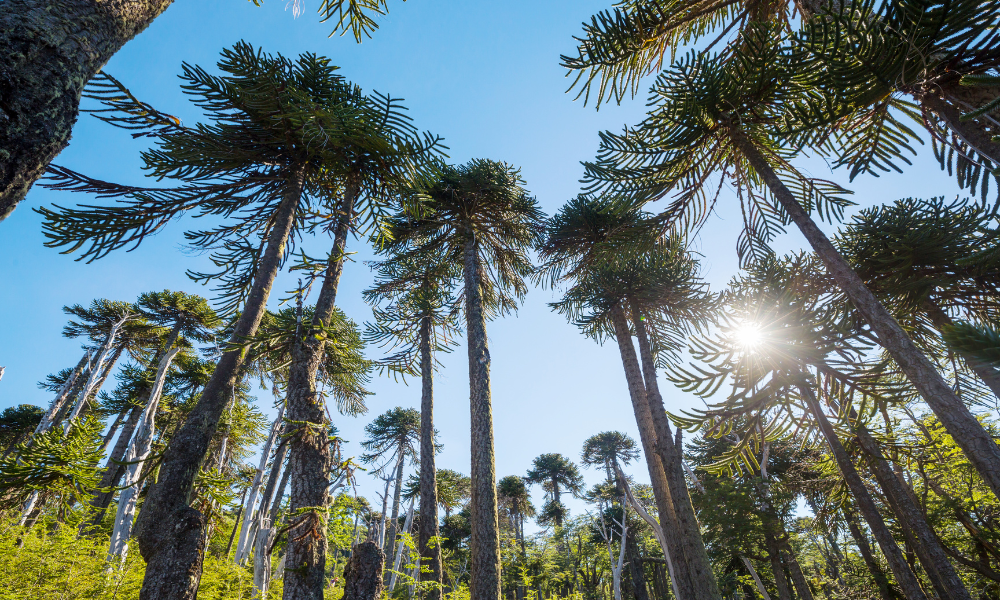Types of Forests in Chile
Each year on March 21st, this day is celebrated to raise awareness of the importance of forests for both our planet and our lives.

Chile is a country that has a wide variety of forests, thanks to its enormous territorial extension, diverse climate, and the influence of geographical barriers, such as La Cordillera de los Andes– The Andes Mountain- and El Desierto de Atacama- and The Atacama Desert. Due to this, there are diverse ways to classify vegetation. According to Gajardo’s (1994) natural vegetation classification, it is possible to classify the various types of plants by their adaptations, floristic characteristics, spatial structure and phytogeographic origin, resulting in a classification system of plant groups at different spatial scales. The following is a description of forest types present in our country.
Scrubland and Sclerophyll Forest: This type of forest is located in the central and coastal zones of Chile. As a result of its geographical location, it has developed its life cycle in the Mediterranean climate; therefore, there are species of high tolerance to water stress thanks to their tiny, leather-like leaves (hard, and flexible), and crooked trunks with exceptional fire resistance. They form complex vegetation landscapes on account of the high degree of alteration associated with the high population density of this zone. The predominant species are generally shrubby with sclerophyll leaves, succulent, and prickly and some of them grow with ease at high heights. Some of the most numerous ones are: boldo (Peumus boldus), litre (Lithraea caustica), peumo (Cryptocarya alba), quillay (Quillaja saponaria) and maitén (Maytenus boaria).
Deciduous Forest: It is a vegetation formation located in the central zone of Chile from the regions of Valparaíso to Los Ríos in mountainous areas. It grows in temperate climates, generally influenced by short-term drought in the summertime. This type of forest is one of the most threatened and fragmented in the country because of the agricultural and urbanization growth. One distinctive feature of this type of forest is the presence of some Nothofagus species, such as roble blanco (Nothofagus obliqua var. macrocarpa), which has deciduous leaves. Other common species are peumo (Cryptocarya alba), litre (Lithrea caustica) and ciprés de la cordillera (Austrocedrus chilensis) which has an important role in The Andean Mountain.
Laurifolio Forest: This type of forest is found in various regions worldwide, including Chile. It is characterized by having evergreen trees; that is to say, they retain their leaves during the entire year. The laurifolio forest is mainly found in the region of Los Lagos in the south of Chile. This forest grows on the coastline of a mild and rainy climate with annual rainfall ranging from 2.000 to 4.000 mm. The soils are rich in nutrients; thus, the vegetation permanently grows and renews. Some of the most common species are ulmo (Eucryphia cordifolia), oak (Nothofagus obliqua), myrtle (Luma apiculata), and coihue (Nothofagus dombeyi).
Andean Patagonian Forest: This type of forest is in Chilean and Argentinian Patagonia throughout The Andes Mountain (between the VIII and X regions). A particular and determining factor in these species' growth is that they form communities in zones where it rains in the form of sleet. The predominant species is the lenga (Nothofagus pumilio), which participates, to a greater or lesser extent, in the zone's diverse vegetal communities.
Evergreen Forest and Peatland: This is one of the most diverse types of forests in the world, distinguished by its high levels of precipitation and humidity, which can annually reach 4.000 mm. It covers the south of Chile from the south of La Isla de Chiloé- Chiloe Island- to Cabo de Hornos- Cape Horn. The physical topography conditions are also varied: mountainous zones, hillsides, archipelagos, and ice fields. In these altered zones, it is also possible to find highly humid scrubland, peatlands, and renewable forests. Some common species are araucaria (Araucaria araucana), coihue (Nothofagus dombeyi), lenga (Nothofagus pumilio), and tepa (Laurelia philippiana), among others.
Patagonian Steppe: It is located on the East side of Patagonia and near the geographic border with Argentina. As a result of the gradient climate, the climate conditions in this zone are arid with low temperatures. Therefore, the vegetal communities tend to be homogeneous and of low height, controlled by steppes with tufted grasses (also called coirones because of the abundance of Festuca spp. y Stipa spp.) and other low-height tree species. The species from the Baccharis genus are frequent and well-known for having edible fruit, for example, the calafate (Berberis buxifolia).
References
Gajardo, R. (1994). La vegetación natural de Chile: Clasificación y distribución geográfica. Editorial Universitaria.
Aravena, J. C., & Hildebrandt, P. (2011). Distribución y estado de conservación de los bosques nativos de Chile. Bosques templados de Chile y Argentina: Variabilidad, diversidad y dinámica.Valdivia, Chile: Editorial Universitaria.
Armesto, J. J., Villagrán, C., &; Kalin Arroyo, M. T. (1996). Ecología de los bosques nativos de Chile. Editorial Universitaria.
Donoso, C. (2015). Ecología forestal: Bases para el manejo sostenible y conservación de los bosques nativos de Chile. Marisa Cúneo Ediciones.
INFOR. (2018). Catastro y caracterización de plantaciones forestales en Chile. Instituto Forestal.
CONAF. (2020). Bosques nativos. Corporación Nacional Forestal.
CONAMA. (2008). Clasificación de los ecosistemas terrestres de Chile.
Le Quesne, C., Méndez, M. A., & amp; León, J. (2006). Tipos de bosque de la Patagonia chilena y argentina: Una revisión. Bosque, 27(2), 109-122
Muñoz, A. A., & amp; Armesto, J. J. (2009). Los bosques de Chile central y su biodiversidad: Un nuevo modelo de gestión para la conservación y restauración ecológica. Revista chilena de historia natural, 82(1), 103-123.
Villagrán, C., Armesto, J. J., & Kalin Arroyo, M. T. (1981). Aspectos biogeográficos de la flora del bosque valdiviano. Anales del Instituto de la Patagonia, 12, 121-131.